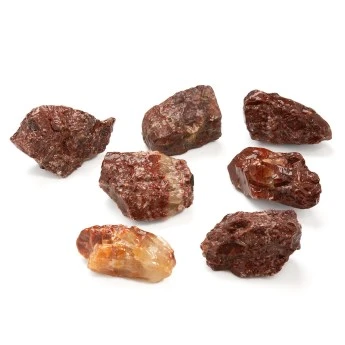Calcite: Properties, Facts and Photos

What is Calcite?
Calcite is a common form of calcium carbonate, a chemical compound found in many minerals in nature. The mineral aragonite is another crystalline form of calcium carbonate.
Calcite is well known for its spectacular and varied crystal formations, of which there are more than 300 different types.
Calcite is documented to have more crystal forms than any other mineral. Its crystal habit is often described as ‘massive’, meaning its crystals are tightly intergrown and form one large mass. Individual crystal faces are not visible, and the material shows no distinct external crystal shape.
Calcite crystals can vary dramatically in size and shape and can be found in almost any colour. In its purest form, calcite is either colourless, very pale or white.
Crystals can demonstrate double refraction of light, correctly known as birefringence. This means the crystal splits in two when light passes through, creating a double image.
Double refraction is widely used in optical applications. The type of calcite that exhibits this property is known as optical calcite or Iceland Spar.
During the process of double refraction, polarised light travels through the crystal at different speeds and in different directions. As a result, one of the rays is bent at an angle or 'refracted' whilst the other remains unchanged.
A good example of refraction is a pencil in a glass of water. At the point where it enters the water, it appears to be misaligned. This optical illusion is caused by the refraction of light. Light bends at the point where the pencil meets the water but then continues in a straight line.
Calcite, one of the most common minerals on Earth, forms many rock types, including limestone, marble, and travertine. It can also be found in caves as stalagmites and stalactites.
Calcite is the main component in the shells of sea creatures. As they die and fall to the seabed, more rocks rich in calcium are created. The process takes place over millions of years.
Calcite is so widespread that it can be found in almost every country in the world.

The properties of calcite make it one of the most widely used of all minerals. Large blocks of limestone and marble have been used in construction for thousands of years.
Although these stones are seen as being more exclusive building materials today, both are still widely used in the production of cement and concrete.
White and yellow calcite, which were mined extensively in ancient Egypt, were used in everything from buildings to vases to the eyes in statues.
The Sphinx of Memphis believed to have been carved between 1700 and 1400 BC, is the largest calcite statue ever discovered. The Great Pyramid of Egypt was once covered with limestone. It's estimated that 5.5 million tons would have been used to create it.
Calcite grades 3 on the Mohs scale of mineral hardness, so it scratches very easily. Some metaphysical-related articles, particularly online, have linked a mineral's hardness to its suitability for submersion in water. There is no truth in this at all.
The articles claim minerals graded less than 5 on the Mohs scale should not be allowed to get wet. However, a mineral's hardness has nothing to do with how it reacts when submerged in water.
In most tap water suitable for drinking, there's not enough acid present to cause significant damage. With that said, carbonate minerals such as calcite do not react well to acid, so ideally, should not be allowed to get wet.
When exposed to the tiniest drop of acid, calcite will effervesce and over extended periods of time can begin to dissolve.
Water with high levels of iron can stain a mineral, but these levels of iron are uncommon in drinking water.
Pink, yellow, orange and blue calcite are widely used for decorative purposes. When used as a gemstone, calcite tends to be shaped as a cabochon.
The Meaning of Calcite
The meaning of the word 'calcite' comes from the German 'calcit'. 'Calcit' comes from the Latin 'calx', which means 'lime'.
In Old English, the word 'cealc' referred to 'chalk', which is a soft, white limestone. It could also encompass the meanings of 'lime' and 'plaster'.
'Cealc' was sometimes used to describe a small stone or pebble.
The suffix 'ite' is widely used for minerals named after people, places or substances. Examples include charoite, labradorite, sugilite and pietersite, but there are many more.
There's even an 'Englishite'. This rare mineral was named after George Letchworth English. The name would make many Northerners laugh. 'Northerner' is a term used to describe people who live in the northern part of the United Kingdom.
In this region, the word 'shite' is often used instead of the more common word for poop.
Article Pictures
Both of our calcite photos are courtesy of Stan Celestian. The twin crystal at the top is from Cumbria, United Kingdom. The dog-tooth spar is from Mexico.
Images are clickable and redirect to the original photo.
Pop-up photo: Optical calcite - Courtesy of Stan Celestian.












